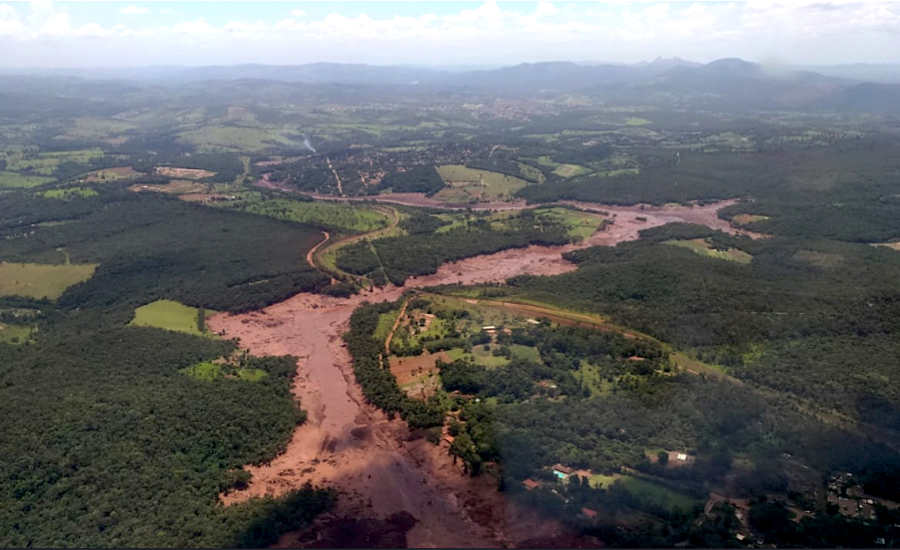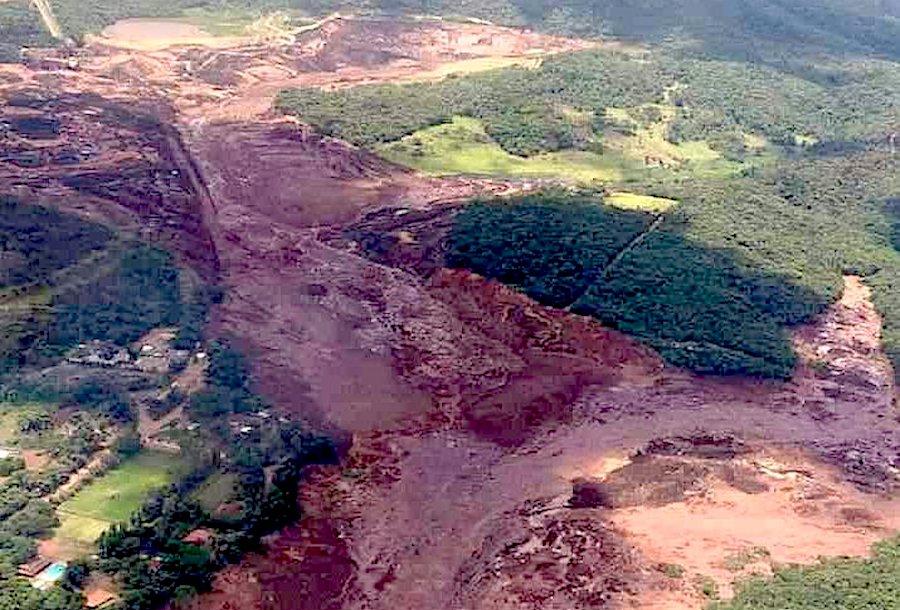Hundreds still missing following Vale’s dam break in Brazil

A tailings dam at a Brazilian iron ore operation owned by local mining giant Vale (NYSE:VALE) burst Friday, releasing a river of sludge that covered nearby buildings and forced the evacuation of hundreds of locals.
By Saturday morning, 34 bodies had been recovered, and the death toll was expected to rise sharply as rescuers continued searching for hundreds that are still missing.
Vale reported the dam breach Friday morning, adding that the leaked tailings from the Feijão mine in the state of Minas Gerais had spread into the mine’s administrative area and to parts of the local community Vila Forteco, near the town of Brumadinho.

Image: @deputadoadelmo | Twitter.
The accident panicked locals who still have vivid memories of the deadly dam failure at Samarco, BHP and Vale’s joint venture, which killed 19 people in 2015 and became the country’s worst ever environmental disaster.
“No lessons were learned from the Mariana tragedy,” Greenpeace Brazil campaign coordinator Nilo D’Avila told JovenPam. “It’s the same company and the same kind of accident.”
Vale CEO Fabio Schvartsman said the dam at the Feijão mine had a capacity of 12 million cubic metres, far less than the 50 million cubic metres Samarco’s one had in 2015. He added the facility was being decommissioned and that equipment had shown the dam was stable on Jan. 10, Reuters reported.

Image: Portal R7.com | Twitter.
Brazil’s President Jair Bolsonaro lamented the incident on Twitter, adding he was sending three cabinet ministers to the area. “Our greatest concern at this time is to attend to possible victims of this serious tragedy,” he wrote.

Earlier on Friday AFP agency reported there were “several” deaths as a consequence of the tragedy and Vale acknowledged in an emailed statement that there were “possible victims” among employees who were at “an administrative facility” hit by the mud.
Brazil’s National Mining Agency on Saturday ordered Vale to suspend operations at the mine and Minas Gerais state prosecutors entered a motion to freeze 5 billion reais ($1.3 billion) in the company’s accounts for handling damages. It’s expected that more funds will be frozen in days to come.
Record TV Minas caught the moment a victim was rescued by the fire corps helicopter:
The Feijão mine is part of Vale’s southern system operations, which is made up of three mines and two ports and accounts for about a quarter of the company’s iron ore output, according to RBC Capital Markets.
Shares in Vale, the world’s number one iron ore producer, cratered on the news and were trading almost 10% lower in New York at $9.76 by 2:05pm local time. The company’s bonds due in 2022 also fell, hitting their lowest price since 2017.
(With files from Reuters)
Now read: Panic after fresh alert at another mine in Brumadinho complex
More News
Anglo starts talks with banks on possible De Beers IPO
Anglo is pursuing a dual-track process in its effort to exit De Beers by trying to find a buyer for the struggling business.
March 28, 2025 | 12:19 pm
PDAC JV video: Golden Pursuit preps for discovery at sub-Arctic Gordon Lake, CEO says
A program to scan archived core using AI and expand geophysical surveys on the Wooferine-Lynk Zones is set to start soon.
March 28, 2025 | 11:35 am
{{ commodity.name }}
{{ post.title }}
{{ post.excerpt }}
{{ post.date }}



5 Comments
Juan Heller
What is going on in Brazil? It’s what, the fourth similar occurrence in the past five years?
Karin Hall
Gotta love how Vale refers to this disaster as a ‘Leak’. Any sane individual or entity would have the courage to call it a ‘Collapse’.
gil knappmiller
–this will be used by the “environmental” anti-mining movement for decades—
deedub93
Governments need proper dam engineers on board when carrying out inspections. It’s so easy to pull the wool over the eyes of mine inspectors because they generally do not have adequate knowledge. 3rd party reviewers need to be employed by the regulatory authorities not the mine owners, then a more balanced picture would be given, and many, if not all catastrophes could be avoided.
Tailings dams are like step-children, they have to be there but they are never the number one priority. When funds or plant are in short supply and it is a choice between production or TMF, the TMF normally suffers.
Mine geotechnical engineers are generally a lonely bunch, most constantly warn mine management that there are risks, but the reply is always the same, “you always say that, and it’s not failed yet”. When one has to say “I told you so” it’s too late.
Investors might do well to employ dam engineers and take them on their site visits too. Many take ‘mining experts’ to review process, mining techniques, ore bodies etc. but few of these experts have in depth dam knowledge. Remember, a tailings dam built too steep or almost full will little chance of a raise in the near future is often the first sign that all is not well with the company.
Muhammad Shabbir
• Key issues & reforms for the Dam Sites:
1. Emergency Spillway System Construct somewhere behind the upstream area which must be first priority to meet such kind of happened, easily escaping from high flood situations.
2. The Diversion Tunnels as per design criteria round shape with RCC Complete before the heavy Rains & flood periods to bear the impacts of Static and other relevant forces of underground and Main Structure areas avoiding from Sliding’s, Cracks, Sink Holes & settlement factors.
3. The Project sites need to be add in provision of specific Cofferdams to controlling the water reservoir potential of upstream areas and not going towards the Dam sides, over Toping, especially protecting from the Leakages.
4. The Storage Capability in the Reservoir as per depend upon the Geological Site Condition of Soil and Rock Strata (Earth Works Status of 5 years , Earthquakes, Hydrology, previous disasters in 10 year results) also the Fracture and Weak Zones need to must be address)
5. Reviews must be considering as per Site Conditions in design criteria consulting during the Construction of Project Site execution stage wise pattern accordingly>???